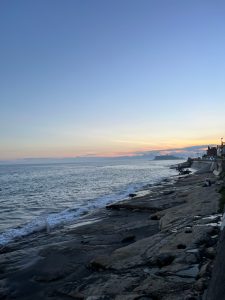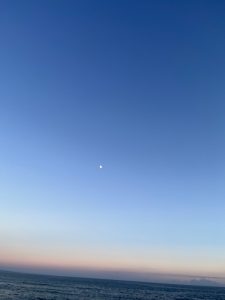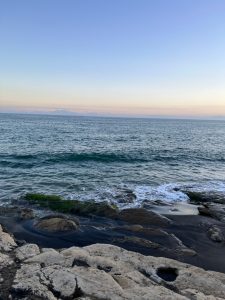稲村ケ崎(愛知県名古屋市千種区姫池通 骨董買取 古美術風光舎名古屋店)
2022.09.11
みなさまこんにちは、スタッフNでございます。
サンダルが大好きで、毎年ギリギリまでサンダルを履いております。
今年はどこまでいけるでしょうか。
知人から稲村ケ崎の写真が届きました。

夕日がグラデーションになっていて、とてもロマンティックですね。
稲村ケ崎と言えば、サザンオールスターズというイメージがあります。
「君こそスターだ」という曲の冒頭で「稲村ヶ崎は今日も雨~」と歌っておりますね。
子供のころに、友達の家族に付き添ってサザンオールスターズのコンサートに行ったことがあるのですが、まだピュアな子供だったNは、桑田佳祐の下ネタにとても驚いた記憶がございます。
そして、たくさんの大人たちが、子供みたいにこんなに楽しくはしゃぐのを初めて見たので、サザンオールスターズってすごい!!と感動しておりました。
実は、Nは鎌倉に行ったことがございません。
ずっと鎌倉に行ってみたいな~と思いながら、行けずにおります。
来年こそは行ってみたいです。
浮世絵などにも登場致します、稲村ケ崎について調べてみました。
稲村ヶ崎は、江ノ島電鉄稲村ヶ崎駅から徒歩5分、神奈川県鎌倉市南西部にある岬で、由比ヶ浜と七里ヶ浜の間にあたります。
通常、「稲村ヶ崎」の表記は歴史的用法や国の史跡の名称に使用し、地名としては住居表示に伴う町名変更で稲村ガ崎一丁目から稲村ガ崎五丁目となっております。
地名の由来は、稲穂を重ねたように見えるためだと言われております。
古来良質な砂鉄が採取できることで知られ、古代にはこの地で製鉄がおこなわれていたと考えられています。
奈良時代の鎌倉には「見越しの崎」あるいは「御輿の崎」「神輿の崎」と呼ばれる地名があったことが知られており、万葉集に、
鎌倉の 見越しの崎の 岩崩(いわくえ)の 君が悔ゆべき 心は持たじ— 万葉集 巻14-3365
と詠まれています。
この地名がどこを指すかについては、長谷の甘縄神社裏山という説と稲村ヶ崎という説があり、確定していないそうです。
しかし、岩崩の名所として知られていたならば、稲村ヶ崎説が有力となるそうです。

新田義貞による稲村ヶ崎突破の場面で、義貞が太刀を海に投げ入れると竜神の奇跡により潮が引き、そこから鎌倉を攻めたという伝説があります。
鎌倉時代末期の元弘3年(1333年)5月に上野国(群馬県)新田荘を本拠とする新田義貞が挙兵し、分倍河原の戦いと関戸の戦いで北条氏の軍に勝利して鎌倉に迫りました(鎌倉の戦い)。
5月18日、新田軍は極楽寺口より攻撃を加え、21日には義貞自ら稲村ヶ崎の海岸を渡ろうとしましたが、当時の波打ち際は切り立った崖となっており、石が高く、道が狭小なため軍勢が稲村ヶ崎を越えられませんでした。
そこで、義貞が潮が引くのを念じて剣を投じると、その後潮が引いて干潟となったので岬の南から鎌倉に攻め入ったという伝説が『太平記』に記されております。
ただし、近年において天文計算により、稲村ヶ崎の潮が引いたのは18日のことであったことが明らかになり、『太平記』の日付には誤りがあると考えられているそうです。
1333年(元弘3年5月)の新田義貞の鎌倉幕府攻めの際、通行困難だったが義貞徒渉の際には干潟となって容易に進軍できたという伝説より、「稲村ヶ崎(新田義貞徒渉伝説地)」として、 1934年(昭和9年)3月13日、国の史跡に指定されました。
幕末には外国船監視のための台場が置かれ、長州藩が防衛にあたった。
1928年(昭和3年)、県道片瀬鎌倉線(後の国道134号)の開削工事が行われ稲村ヶ崎の丘陵が分断されて切り通しが開かれました。
また、第二次世界大戦中には伏龍隊の地下基地がありました。
1960年代から付近の丘陵地が大規模住宅地として開発され、1969年には住居表示実施に伴う町名変更で旧大字極楽寺から分離され、稲村ガ崎一-五丁目となりました。
現在は鎌倉海浜公園として整備されていて、園内には逗子開成中学校ボート部七里ヶ浜沖遭難事件(1910年)の慰霊碑(『真白き富士の根』の歌詞を刻む)、コッホ博士記念碑などもございます。
サーフィンのメッカとして有名であると同時に、海水浴場としても使用されてきましたが、近年、砂の流出が進み、2003年(平成15年)からは海水浴場としての使用は行われなくなりました。
2000年に温泉が発見され、後に「稲村ヶ崎温泉」となります。
古美術風光舎では、稲村ケ崎の浮世絵や絵画なども買取しております。
ではでは

Hello everyone, this is Staff N.
I love sandals and wear them every year until the last minute.
How far can we go this year?
I received a photo of Inamuragasaki from an acquaintance.
The setting sun has a gradation and is very romantic.
Speaking of Inamuragasaki, there is an image of Southern All Stars.
At the beginning of the song “Kimi wa Star Da”, you sang “Inamuragasaki is raining again today~”.
When I was a child, I went to a Southern All Stars concert with my friend’s family.
And I’ve never seen so many adults having fun like children, so Southern All Stars is amazing! ! I was impressed.
Actually, N has never been to Kamakura.
I’ve always wanted to go to Kamakura, but I haven’t been able to.
I would like to go there next year.
I researched about Inamuragasaki, which also appears in ukiyo-e.
Inamuragasaki is a cape located in the southwestern part of Kamakura City, Kanagawa Prefecture, a 5-minute walk from Inamuragasaki Station on the Enoshima Electric Railway, between Yuigahama and Shichirigahama.
Usually, the notation of “Inamuragasaki” is used for historical usage and names of national historic sites, and as a place name, the town name was changed from Inamuragasaki 1-chome to Inamuragasaki 5-chome due to a change in the name of the town along with the indication of the residential address.
It is said that the origin of the place name is because it looks like ears of rice are piled up.
It has been known since ancient times for its ability to extract high-quality iron sand, and it is believed that iron manufacturing was carried out in this area in ancient times.
It is known that Kamakura in the Nara period had place names called ‘Mikoshi no saki’, ‘Mikoshi no saki’ or ‘Mikoshi no saki’, and in the Manyoshu,
Kamakura’s Mikoshi-no-zaki Iwakue You have a heart that you should regret—Manyoshu Vol. 14-3365
It is said.
Regarding where this place name refers to, there are two theories: the mountain behind Amanawa Shrine in Hase, and the theory that it is Inamuragasaki.
However, if it was known as a famous spot for rock collapses, the theory of Inamuragasaki would be more convincing.
There is a legend that when Yoshisada Nitta threw his sword into the sea, the tide receded due to a miracle of the dragon god, and he attacked Kamakura from there.
At the end of the Kamakura period, in May 1333, Yoshisada NITTA, based in Nitaso in Ueno Province (Gunma Prefecture), raised an army and defeated the Hojo clan’s army in the Battle of Bubaigawara and the Battle of Sekido. and approached Kamakura (Battle of Kamakura).
On May 18, Nitta’s army attacked from Gokurakujiguchi, and on May 21, Yoshisada himself tried to cross the coast of Inamuragasaki, but at that time the beach was a sheer cliff and the stones were high. The road was so narrow that the army could not cross Inamuragasaki.
There is a legend in the “Taiheiki” that says that when Yoshisada threw his sword in anticipation of the ebb of the tide, the tide would recede and the tidal flats would form, so Yoshisada attacked Kamakura from the south of the cape. .
However, in recent years, astronomical calculations have revealed that the tide at Inamuragasaki receded on the 18th, and it is believed that the date in the “Taiheiki” is incorrect.
When Yoshisada Nitta attacked the Kamakura shogunate in 1333 (May 3rd year of Genko), it was difficult to pass, but when Yoshisada crossed it, it became a tidal flat and the army could easily advance. It was designated as a national historic site on March 13, 1934 (Showa 9).
At the end of the Edo period, Daiba was set up to monitor foreign ships, and the Choshu clan took charge of defense.
In 1928 (Showa 3), excavation work was carried out on the Katase-Kamakura Prefectural Road (later National Route 134), and the hills of Inamuragasaki were divided and a cut was opened.
In addition, during World War II, there was an underground base for the Furyutai.
Since the 1960s, the nearby hilly area has been developed as a large-scale residential area, and in 1969, due to the change in the name of the town accompanying the implementation of residential address indication, it was separated from the former Oaza Gokurakuji and became Inamuragasaki 1-5 chome.
Currently, it is maintained as Kamakura Seaside Park, and in the park, there is a memorial monument for the Zushi Kaisei Junior High School rowing club accident off Shichirigahama (1910) (inscribed with the lyrics of “Pure White Fuji no Root”), a monument to Dr. Koch, etc. We also have
It is famous as a mecca for surfing and has also been used as a beach.
A hot spring was discovered in 2000 and later became Inamuragasaki Onsen.
At Antique Fukousha, we also purchase Ukiyo-e and paintings of Inamuragasaki.
See you soon
*********************
ご実家の整理やお片付けなどをされている方のご相談などが多くございます。朝晩少し涼しい季節となってまりましたが、でくれぐれもご無理のないようになさってくださいませ。風光舎では古美術品や骨董品の他にも絵画や宝石、趣味のお品など様々なジャンルのものを買受しております。
お片付けをされていて、こういうものでもいいのかしらと迷われているものでも、どうぞお気軽にご相談下さいませ。
また風光舎は、出張買取も強化しております。ご近所はもちろん、愛知県内、岐阜県、三重県その他の県へも出張いたします。
まずは、お電話お待ちしております。
愛知県名古屋市千種区・骨董 買取
『古美術 風光舎 名古屋店』
TEL052(734)8444
10:00-17:00 OPEN
#稲村ケ崎#古美術風光舎#浮世絵#骨董#買取#古書買取

